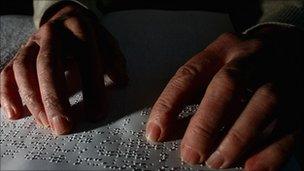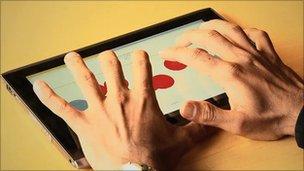Tablets turned into Braille keyboard by US researchers
- Published

Braille can seem outdated in a world where touchscreens are ubiquitous
A team of US researchers has devised a way for people with impaired vision to use the touchscreen of a tablet such as an iPad as a Braille keyboard.
It turns some previously fundamental thinking about how to make technology accessible to blind people on its head.
Instead of using a keyboard or mechanical writer, users type directly onto the flat glass.
The inventors used a novel design for the keyboard to overcome the lack of tactile features.
Smart keyboard
"Instead of having fingers that find the buttons, we built buttons that find the fingers," said Stanford's Sohan Dharmaraja, one of the researchers on the project.

The software creates a smart keyboard for users
Users place eight fingers on the screen and the keyboard appears. Shaking the device activates a menu, and further interaction is achieved by regular touch gestures.
Mr Dharmaraja, alongside team-mates Adam Duran - an undergraduate from New Mexico University - and assistant professor Adrian Lew, came up with the idea during a boffin's X-Factor-style contest.
The competition, organised each year by Stanford University, challenges students to come up with some innovative future computing ideas over their summer break.
In demonstrations Mr Duran typed out a complicated mathematical formula and the chemical equation for photosynthesis.
But it also offers a solution for more basic problems.
"Imagine being blind in the classroom, how would you take notes? What if you were on the street and needed to copy down a phone number? These are real challenges the blind grapple with every day," said Prof Lew.
There are some obvious benefits to using touchscreen technology over traditional Braille writers.
"Current physical note takers are big and clunky and range from $3,000 (£2,000) to $6,000 (£4,000). Tablet PCs are available at a fraction of the cost and do so much more," said Mr Dharmaraja.
Promising development
As part of the project, the students had to learn Braille. The system, originally developed for the French military, is made up of six dots arranged in various patterns. They are read by people's fingertips.
But the system can seem outdated in a modern era where touchscreens are ubiquitous.
Accessible touch screen devices such as the iPad offer a huge range of possibilities for developers and for blind and partially sighted people," said Robin Spinks, the Royal National Institute for Blind People's manager of digital accessibility.
"This prototype Braille keyboard for touch screen devices represents a very promising development, and RNIB look forward to being able to test it with our members in the future," he added.
It may be some while until the Stanford project is turned into a commercial reality but the team are determined.
"Who knows what we will get because of this device. It is opening a door that wasn't open before," said Mr Dharmaraja.
- Published12 October 2010